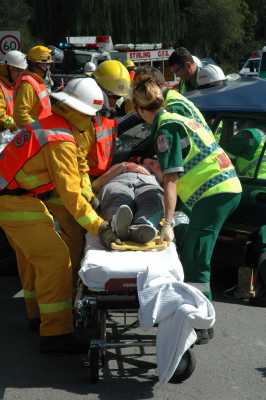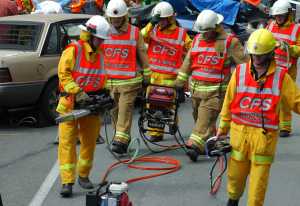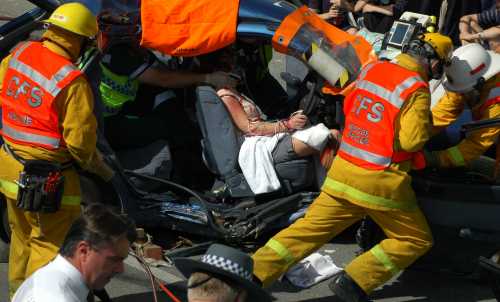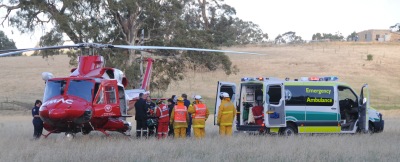
This work is licensed under a Creative Commons Attribution-ShareAlike 4.0 International License

Road Crash Rescue
Using the Jaws of Life

Around a quarter of all calls attended by the CFS are vehicle related - which have involved a number of fatalities.
CFS Volunteers provide Road Crash Rescue (RCR) response to over 90% of South Australia. Specialist brigades carry Hydraulic tools and other equipment, used to extricate injured people from crashed vehicles.

The CFS carries a wide range of Hydraulic tools, commonly referred to as 'the Jaws of Life'. These may include cutters (used to cut metal), spreaders (which may be used to force different pieces of metal apart or crush metal ready for cutters), and rams, (used to force parts of the car apart). The tools are categorised into either Heavy or Light equipment.
Light RCR Equipment may simply consist of a small motorised hydraulic pump and a combination tool - both a cutter and spreader in one.
Heavy RCR Equipment will consist of a set each of cutters and spreaders, a selection of rams with chains and hooks, as well as an extensive collection of blocks, chocks and wedges to assist in the stabilisation of a crashed vehicle.
Other equipment carried may include a 'Halligan' tool which can assist in opening ('popping') car doors, or preparing the vehicle for using hydraulic tools, air lifting devices used to lift a vehicle, tools for securing over undeployed airbags in vehicles, to contain the air bag should it deploy while rescuers are working.

CFS crews will work closely with Paramedics to remove a casualty from a crash in a safe and timely manner. To start with, the CFS make sure the vehicle is safe to work around by removing any hazards, such as powerlines, leaking fuel or an unstable vehicle. Blocks and chocks are used to stop any movement of the vehicle, and ropes and ties, combined with stabiliser bars ensure the vehicle will remain still. The Paramedics can then work to stabilise the casualty's condition. Once the Paramedics have the casualty as stable as possible, CFS crews can start to pull the vehicle apart.
In rescuing a casualty from a crashed vehicle, the general principal is: 'to remove the vehicle from around the casualty, not the casualty from the vehicle'. This minimizes the movement of the casualty to prevent aggravating any injuries that the casualty may have.
All crews working around the vehicle will wear suitable protective clothing, including safety glasses and gloves. The casualty is also protected from flying glass or metal fragments by a blanket, or by special plastic protectors.
For seriously injured casualties, the sooner they are in hospital, the better. Thus, the quicker CFS crews can remove the patient, the better. However, in a badly crashed vehicle, it is not uncommon for crews to take up to an hour to remove the casualty.
Once the casualty is out of the vehicle, they are transported to hospital. Depending on which area of the state they are in, they may be taken by road ambulance, the Rescue 51 or Rescue 52 Helicopter, or the Royal Flying Doctor Service plane. It is common for CFS crews to be called in to assist with marking or lighting the landing area.

Photographs on this page taken by the CFS Promotions Unit






